What do YOU collect?
Send photos and a description of your collection to bulletin@kenyon.edu. Your prized possessions could be featured on the Bulletin’s website. Scroll down to view reader submissions.
From pilgrimage souvenirs to rubber ducks, peek inside the personal collections of Kenyon alumni and faculty.
Story by Liz Logan
The short novel “Utz,” by Bruce Chatwin, tells the story of a collector: Kaspar Utz, who, while living in Prague under the Communist regime, fills his two-room flat with more than 1,000 porcelain figurines from Germany. Each year, he’s allowed to leave the country, yet he always returns; he can’t take his collection with him, and he can’t bear to leave it. Professor of Art History Eugene Dwyer always assigns this book in his seminar, “The History of Collecting,” because it marvelously captures the motivations behind collecting, a nearly universal human endeavor that goes back millennia.
“People collect to impose order onto chaos, to gain some control of their lives and over the world, to make sense of things,” he said. “Collecting led to telling time and collecting data on the planets and stars. For Utz, collecting was a way of creating an alternative reality, out of his aristocratic fantasies, amidst a very depressing Communist state.”
For Dwyer, there are two aspects of collecting: public collecting — museums — and this private, highly personal collecting. The history of museums, he said, goes back to the funerary temples of the Egyptian pharaohs and treasures of the monarchs of Europe. Then, as societies evolved and middle classes emerged, more people began this type of high-end collecting. “Amidst Holland’s 17th-century prosperity, for instance, people got ‘picture-mania’ and began to collect paintings for their houses,” Dwyer recounts. “All over Europe, people began collecting antiques, especially Roman things.”
In the 19th century, an industry and a culture developed around humble collections, such as coins and stamps. Clubs began to form, and collecting became a social experience. The 1800s also brought more attention to childhood, and children were encouraged to collect things they found in nature and put together displays.
Austin Porter, an assistant professor of art history and American studies, teaches a course on museum studies and, this past spring, his students mounted an exhibition on collecting in the Gund Gallery. “Almost everyone has some sort of collection,” he observed. “You may not think of your collection as being large or special or meaningful to someone else. But it’s a human tendency to want to hold onto things. These things take on a value that transcends monetary worth. What you surround yourself with says a lot about who you want to be and how you want others to perceive you.”
Porter would know. He began collecting matchbooks when he was in high school in the 1990s. “I didn’t smoke,” he remembered, “but they were these interesting, free objects with little cool graphics and letters and designs on them, and a reminder of where I had been.” He estimates that he now has between 500 and 600 matchbooks, which he plans to display in rotating exhibitions: purple matchbooks, match-books from bars, matchbooks with interesting typography, matchbooks from the Midwest. His favorite is one from Kelly’s Westport Inn, a historic bar in Kansas City, down the street from where he lived in his 20s. There’s a small illustration of the bar on the front. “It reminds me of those years between undergrad and grad school, when I was trying to figure out what to do with my life,” he mused. “It was a time of transience and anticipation.”
It’s no surprise that the Kenyon community is full of passionate collectors. Some are collecting valuable master-pieces — from Chinese antiquities to contemporary feminist art — while others have interests that are inexpensive and idiosyncratic, such as rubber ducks and “Jerry Maguire” VHS tapes. No matter the subject matter, these collections are all “very Kenyon” in some way: They’re about curiosity, study, history, preservation and, not least of all, fun.
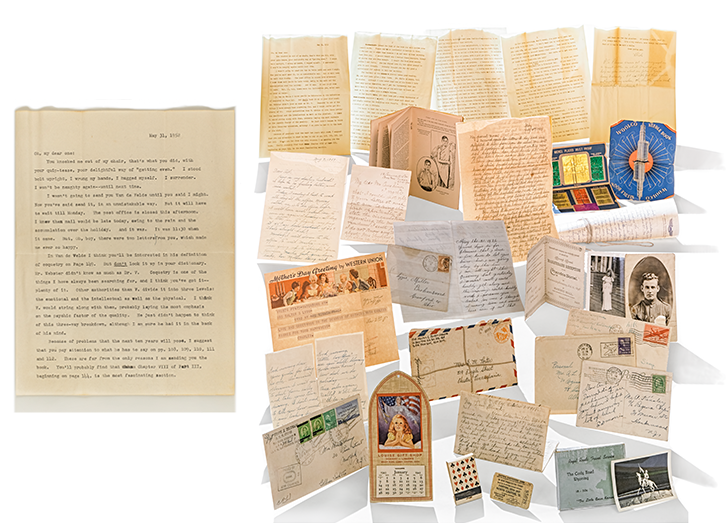
A sampling of Bahn’s letters collection including a letter from Nick Runyon to Dorothy L. Snedaker, dated May 31, 1952.
For Hallie Bahn ’14, old letters open up a window to the past. As a kid growing up in Manhattan, she was fascinated by history and would wander into antique stores to buy old photographs for a nickel. “Once I got a bit older, I realized letters held much more information,” she recalled.
A handful of inexpensive letters from antique stores and estate sales became a larger collection when Bahn was majoring in studio art at Kenyon. She bulked up her collection — mostly letters from 1900 to 1960, because the handwriting of that period is usually legible — in order to make artworks about the passage of time. From there, “it became an obsession,” she said. She enjoys imagining the lives of the authors, to fill in the blanks. “I often find that the authors can’t accept their reality, so they’re doing mind-gymnastics to make their lives more palatable,” she said.
Bahn now has roughly 200 letters, which typically come in packets, often accompanied by the contents of the person’s junk drawer: a movie ticket, needles, an old almanac, a grocery list. At Kenyon, she used the letters to make stop-motion animations on the theme of escapism. She’s now working toward a master’s degree in animation at the Minneapolis College of Art and Design.
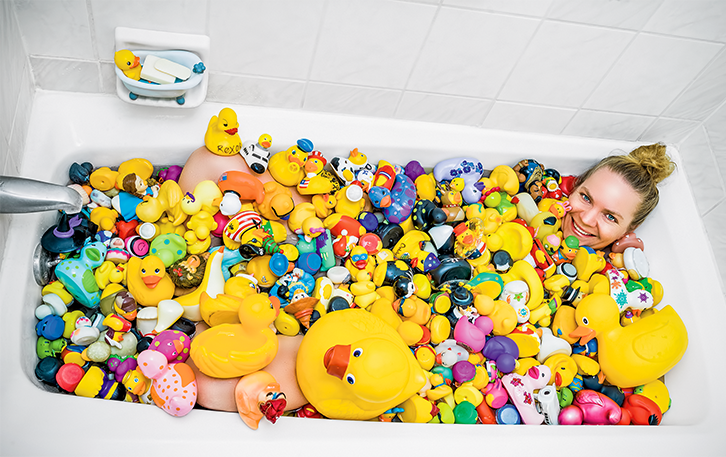
Rose Talbert Meiri ’03 doesn’t remember exactly when or how she started collecting rubber ducks. She knows it has something to do with her nickname in high school, “Duckie,” which originated from “multiple embarrassing things,” she said, with a chuckle. She made up a username for the video game Tetris, combining an animal with her favorite X-Men character — and the result was “Jubilee Duckfast.” The moniker got shortened to “Duckie” over time.
At some point, friends began to give her rubber ducks as gifts, because of her nickname, and she adored them. “It’s hard to not be happy when you look at them,” she said. “They’re just inherently fun and silly. There’s no depressing angle to a rubber duck.” She sought out the ducks in all kinds of stores, such as World Market, which offers seasonal ducks: a pumpkin duck, a turkey duck, a Santa duck. But her collection really grew through additional gifts. Her friends brought her ducks from around the world: “I don’t know when I’ll ever be in England, but I have a Queen’s Guard rubber duck standing guard over my car, on the dashboard.”
Now, Meiri has more than 150 ducks. Her entire life is “ducked out,” she said: every room of her house, her car, her desk at the marketing firm that she co-owns in Los Angeles. When her nieces come over, they run around the house and collect all of the ducks in a huge pile. Meiri found one of her favorite ducks, a red one, in the middle of the street, outside the parking lot of her office. Though the duck was beat-up and cracked in places, the acquisition was a thrill: “I couldn’t believe I found ‘a street duck.’ What are the odds of that?”

For David Horvitz ’74 H’98, his interest in collecting art began around 1985, when he married Francie Bishop Good, an artist and art teacher. Good already had her own contemporary art collection, which she’d mostly procured by trading works with other artists. Horvitz, who runs his own investment management firm, recalled with a laugh, “She dragged me, kicking and screaming, to art galleries. But I admired her passion for it, and eventually I got the bug.”
Good always sought out art that was politically and socially challenging, such as an imposing, racially charged sculpture by Vanessa German. It depicts an African-American woman, along with multiple objects — all cultural stereotypes — some of which are gathered from the artist’s own community in Pittsburgh. “I love this work mostly because it’s reflective of another person’s experience, one very different from mine,” Horvitz observed. “It overtly challenges me to examine my own perceptions. It makes me think about who I am and who I would like to be, and that’s what a lot of great art does.”
Together, Good and Horvitz have collected more than 800 pieces by artists such as Marilyn Minter, Louise Bourgeois, Cecily Brown, Louise Nevelson and Diane Arbus. When they recognized they were collecting works from nearly all female artists, they decided, intentionally, to maintain that focus. In 2006, they founded Girls’ Club, a private foundation and alternative art space in Fort Lauderdale, Florida, where they’ve lived for many years. The space is dedicated to nurturing contemporary women artists and curators and providing free educational programming. “We wanted to share our collection,” Horvitz said, “and we saw an opportunity, because there wasn’t really a hub for cutting-edge, experimental art in our city.” He added, “I’m proud of what we’ve done. Francie’s taught me to be a feminist.”
Web extra: Follow Girls' Club on Instagram and Twitter to find out more about their latest exhibitions and events.

Tom Greenslade arrived at Kenyon in 1964. While poking around in a back room of the physics department one day, he discovered a number of pieces of 19th-century physics apparatus, such as a wooden wave machine. (When the crank is turned, balls mounted on strings move up and down and oscillate back and forth — a visualization of wave phenomena that was used in physics classes of yore.) “They were beautifully made, with brass, mahogany and rosewood,” he recalled. “I enjoyed history, and I liked thinking of previous generations using these instruments.” Greenslade began researching the objects, and a decade later, he found himself giving a lecture on 19th-century physics apparatus at Harvard University.

He kept on researching and giving lectures, and then, in 2000, a physics professor at Oberlin College contacted Greenslade to say that the college was looking to offload a whole cache of apparatus. Greenslade and his wife, Sonia, made several trips to retrieve them, and soon other colleges came calling. By 2005, the Greenslades were building a wing on their Gambier home to serve as a private museum of more than 700 apparatus. It’s now frequented by scholars and anyone interested in physics, or history. Some of his favorite apparatus are a guinea and feather tube, which he used in introductory physics courses to demonstrate that objects in a vacuum fall at the same rate of acceleration; and a refracting telescope that was owned by the family of Lyman Spitzer, the scientist who was known as the father of the Hubble Space Telescope.
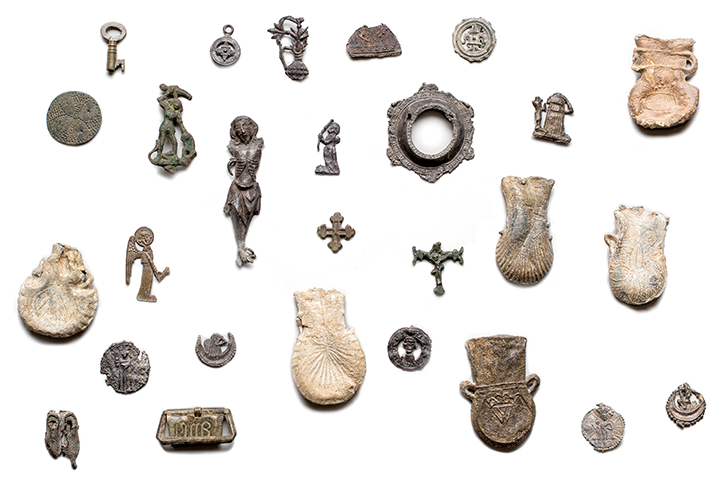
Sarah Blick’s collection of medieval pilgrimage souvenirs, or badges, originated when she was researching these inexpensive metal trinkets for her doctoral dissertation in the early ’90s. The souvenirs were made of alloys of tin, lead or pewter, and they reminded pilgrims of their visit to a shrine of a Christian saint; without them, Blick said, “the pilgrims would actually chip away at the shrine.” There are many accounts of miracles happening because of the tokens: Supposedly, they could heal wounds, extricate horses from deep holes and put out fires . People find these artifacts along the shores of rivers, using metal detectors, so collecting them poses no archaeological threat. It’s likely that pilgrims threw them into rivers for good luck. Blick stumbled upon one such souvenir at a coin shop in Cambridge and felt compelled to buy it for $50. “That was a lot of money for me then,” she recalled, “but I thought, ‘my very own pilgrimage badge!’”
She continued collecting less expensive versions of the souvenirs for a decade — antique shops would often have a coffee mug full of them — because she wanted to share them with her students. She ended up with about 40, including her favorite, a fragment depicting Christ on the cross that was found on the banks of the Thames. “Students are amazed that they can handle something from 13th, 14th or 15th centuries,” she observed. “These souvenirs were popular culture in the Middle Ages, the equivalent of modern-day bumper stickers.”
Recently, Blick’s collecting has taken a distinctly modern turn: She’s collecting Japanese woodblock prints of cats by 20th-century artists such as Kiyoshi Saito and Inagaki Tomoo. The images are stylized and geometric, with bright colors. She explained, “The pilgrimage souvenirs were a research interest, whereas my aesthetic preference is midcentury modern.”

The collection of Chinese ceramics belonging to Jim Breece ’74, which spans the Neolithic period to the 20th century, began when he struck up a conversation with a stranger in a bar in Chicago. The stranger turned out to be the head of Asian Art at Christie’s New York. Through him, Breece became interested in Chinese ceramics, which have a rich history: Among other innovations, the Chinese invented porcelain. His first purchase was a blue and white vase with a handle shaped like a lion, from the Kangxi period in the 1600s. Today, his collection numbers nearly 100 pieces. “Chinese ceramics are incredibly beautiful,” he said. “And, it’s an exciting, competitive field to collect in, because as China has become more affluent, collectors there want things related to their heritage.”
Breece, who lives in the Chicago suburb of Evanston, majored in art at Kenyon. Though he always has worked in the furniture wholesale business, collecting historic objects has been a way for him to continue his art education, learning from museum curators, dealers and others.
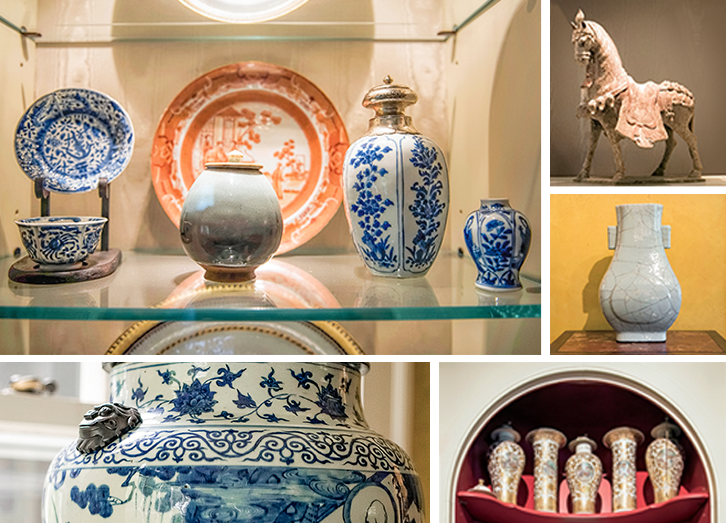
Clockwise from right: Northern Qi prancing horse, circa 560; Imperial Tongzhi Guan glazed vase, circa 1870; An 18th-century five-piece garniture made for the Western market; Late Ming jar with late Qing Dynasty woodenware; Jun beehive water pot, circa 1150, an 18th-century orange Fitzhugh plate and an 18th-century blue and white vase with a European silver mount.
One of his favorite pieces is a pear-shaped porcelain vase from the 18th century with elaborate carvings and a celadon glaze (a green coat that originated in China). “I know it came out of a kiln that made imperial ware, though it doesn’t have an imperial mark,” he said. “As a collector, you have to be inquisitive, do your homework, develop an eye for authenticity.” Recently, he’s put his expertise to use as the deputy director of the Heritage Museum of Asian Art in Chicago, which opened in June. “The world has changed enormously since I studied art at Kenyon, but Asian art is still underexposed,” he said. “I believe strongly that we can learn about other cultures from their objects.”
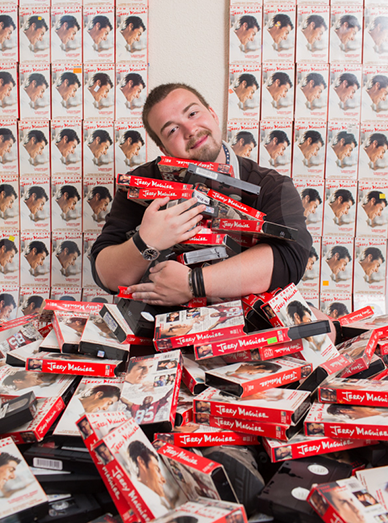
Joe Barden ’15 collects VHS tapes — but not just any VHS tapes. He collects only “Jerrys,” the nickname for VHS tapes of the popular 1996 film “Jerry Maguire,” which starred Tom Cruise and Renée Zellweger. While that may sound bizarre, there is an explanation: “Jerry Maguire” is a very common VHS tape to find in thrift stores and at flea markets, because the movie came out on VHS just when people were switching over to DVDs en masse. As a result, Barden explained, “there are tons of ‘orphan Jerrys’ everywhere.”
The absurdist comedy/performance art collective Everything is Terrible! posts found footage from VHS tapes on the internet, and in 2010, it held a contest to see who could send in the most “Jerry Maguire” tapes. The result was an art installation in Los Angeles, in which thousands of Jerrys were used to build Lego-like structures. Barden was in high school in Seattle at the time, and he and his friends thought it would be fun to get on the contest leaderboard. They scoured thrift stores and accumulated more than 100 tapes. Then, they decided to keep the spoils, rather than send in the tapes. Today, they have about 260.
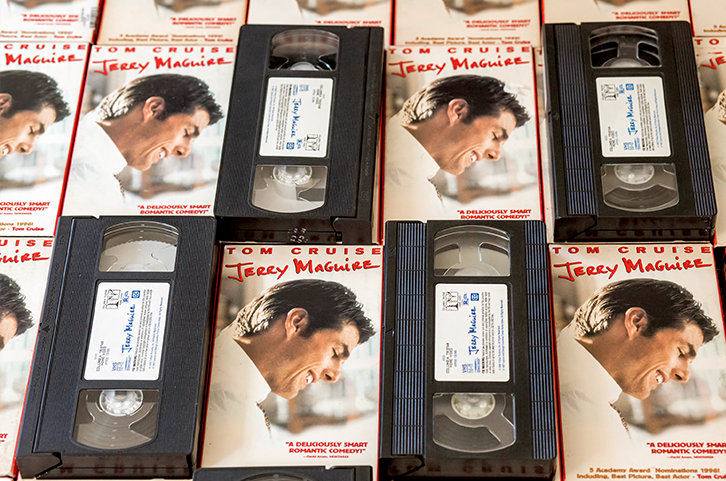
“There’s nothing really philosophical about it,” said Barden, who works as development manager for the Washington State Democratic Party in Seattle. “I love that I can go to a Goodwill with a very clear mission.” In fact, Barden has never actually watched “Jerry Maguire.” “I joke about watching it on my deathbed,” he said. “Whenever I watch it, it will be a momentous occasion.”
Old Letters: Barry Rosenthal
Rubber Ducks: Dana Hursey
Contemporary Art by Women Writers: Benjamin Rusnak
Historical Physics Teaching Apparatus and Pilgrimage Souvenirs: Jodi Miller
Chinese Ceramics: Lauren Justice
Jerry Maguire VHS Tapes: Meryl Schenker
Amy Katz Leaman '94: "Harry Potter" books in foreign languages

The collection began on our honeymoon in 2007. My husband and I visited London, where I bought the British copy of the "Harry Potter and the Deathly Hallows." When we stopped in Paris, the French translation of the "Deathly Hallows" had just gone on sale. In Rome, we found the Italian translation of "Harry Potter and the Sorcerer's Stone." Thus, the bug began. The Dutch, German, Spanish and Icelandic translations came back to the U.S. after my husband's various travels. The remainder came from Amazon.com when prices were reasonable.
I know enough French to pick out Poufsouffle as the French Hufflepuff. Hebrew, which is written without vowels, had to add vowels to the four house names so they could be understood in transliteration. I know enough Hebrew to pick out the part in the book that features the Sorting Hat's song. But I'm unfamiliar with the other languages, so it's just fun to have the books.
I would love to add other translations to my collection and continue to keep my eyes open. There are various websites listing the official translations, from which I've decided that Russian, Modern Greek, Hindi and Gaelic top my wish list.
Andrew Richmond '96: Objects that tell stories
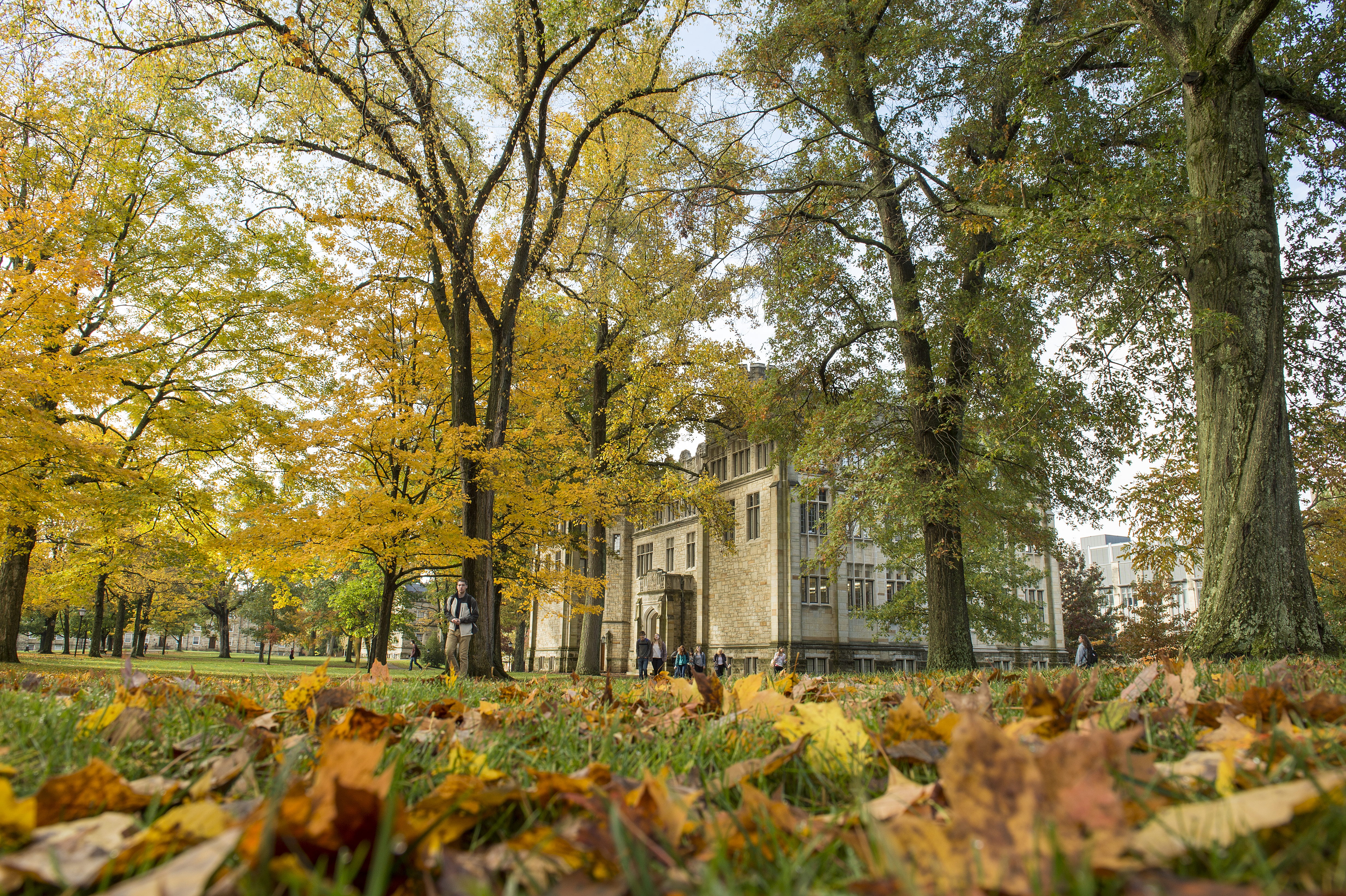
Pictured: Blanket chest, made by Jacob Werrey (1838-1893) for Annabelle Kinkaide, German Township, Fulton County, Ohio, dated 1872.
My wife and I don't collect, per se, we "live with." We live with furniture, decorative arts and paintings from the early Ohio River Valley. Our house is filled with objects that tell stories, sometimes about the makers and users, and sometimes about us and the experiences of acquisition. Our most recent purchase is a painted blanket chest made by a Mennonite carpenter in northwest Ohio. But just as important as the story of the maker and the original owner (we know both) is the chest's more recent history: I sold it more than a decade ago when I was an auctioneer, and it meandered through the hands of multiple dealers and collectors (in Pennsylvania, Connecticut and Delaware) until, finally, it made its way back to me. It now greets me every morning from the foot of the bed, serving as a reminder that our life with objects is a fascinating one indeed.
Matt Richter '86: Coins

Pictured: Roman provincial coins c. 14-37 CE.
I collect ancient and medieval (and occasionally modern) coins. The main foci of my collection are coins minted during the reign of Tiberius (14-37 CE) and Monumental coins (coins with architectural depictions). I also have coins depicting 87 percent of the Roman Emperors and half of the British Monarchs. One Kenyon-related item that is in my collection is a $1 bill featuring Salmon P. Chase. This is an example of the first U.S. $1 bill issued by the U.S. Treasury.
Behind the music with Nick Petricca '09 of the popular rock band Walk the Moon, which got its start at Kenyon.
Read The StoryAt Kenyon, student activists tackle national and international issues — as well as concerns closer to campus…
Read The Story